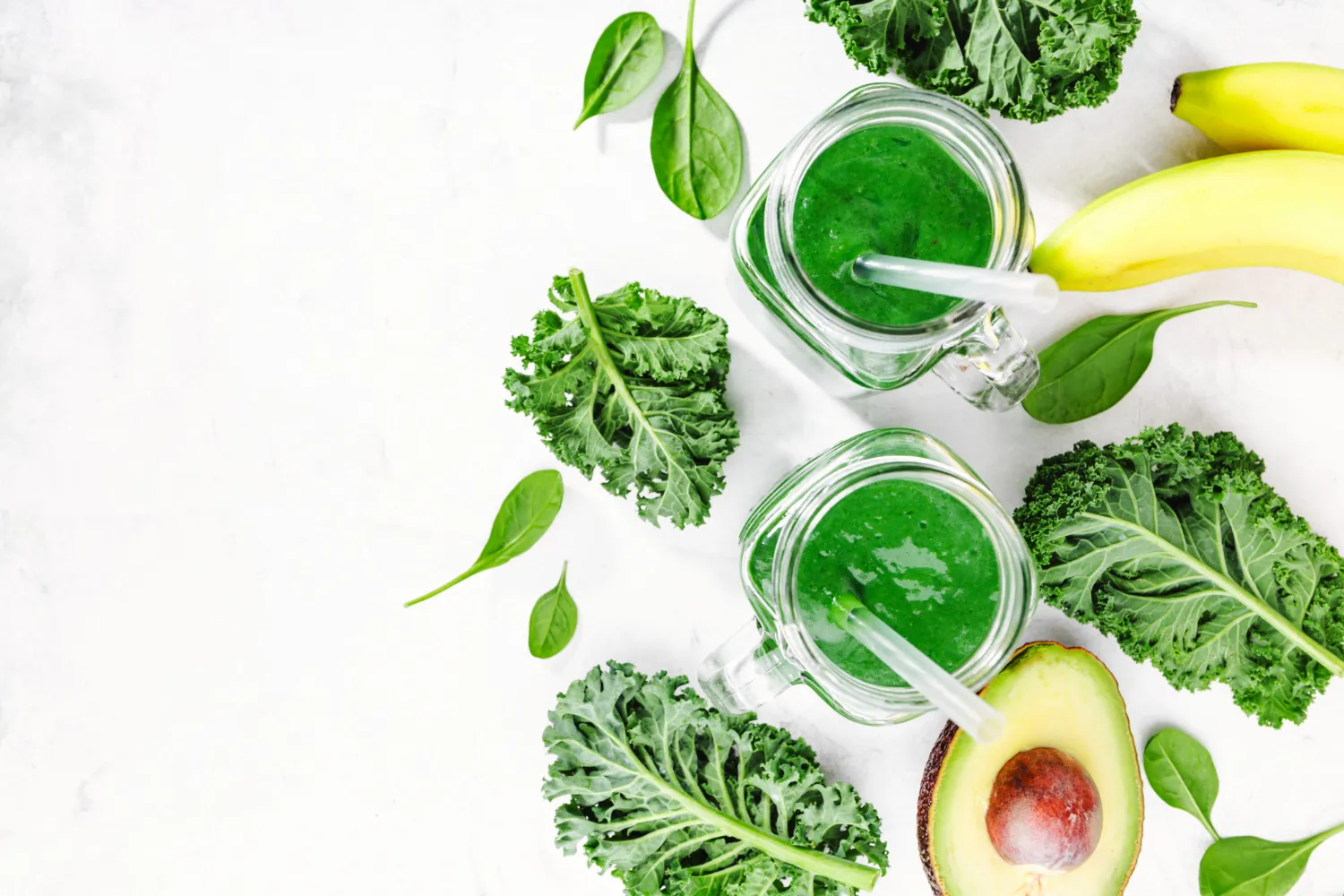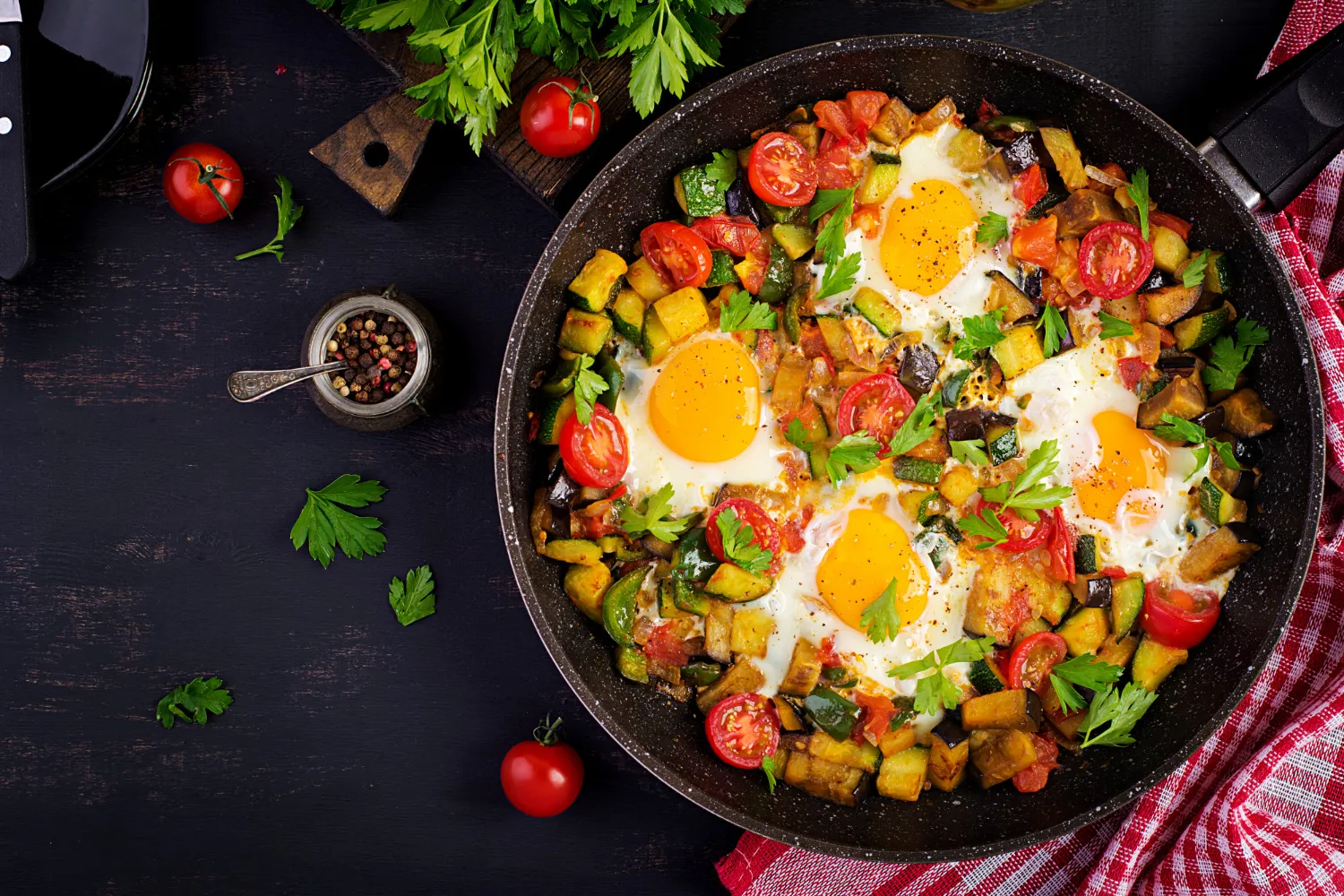The cucumber diet has recently risen in popularity for detox and short-term weight loss. Readily available and nutrient-rich, the diet takes advantage of its high water, low calories, and high fiber content to support weight loss.
For women over 40, these are powerful benefits that can alleviate and address the hormonal, metabolic, and nutritional needs that come with midlife.
However, its severe calorie restriction and lack of vital nutrients raise alarm bells.
In this article, we discuss the 7-day cucumber diet for women and offer a healthier, modified version to help you take advantage of its powerful benefits while still providing the body with adequate calories and vital nutrients for sustainable weight loss.
What Is the Cucumber Diet and Why Do Women Try It?
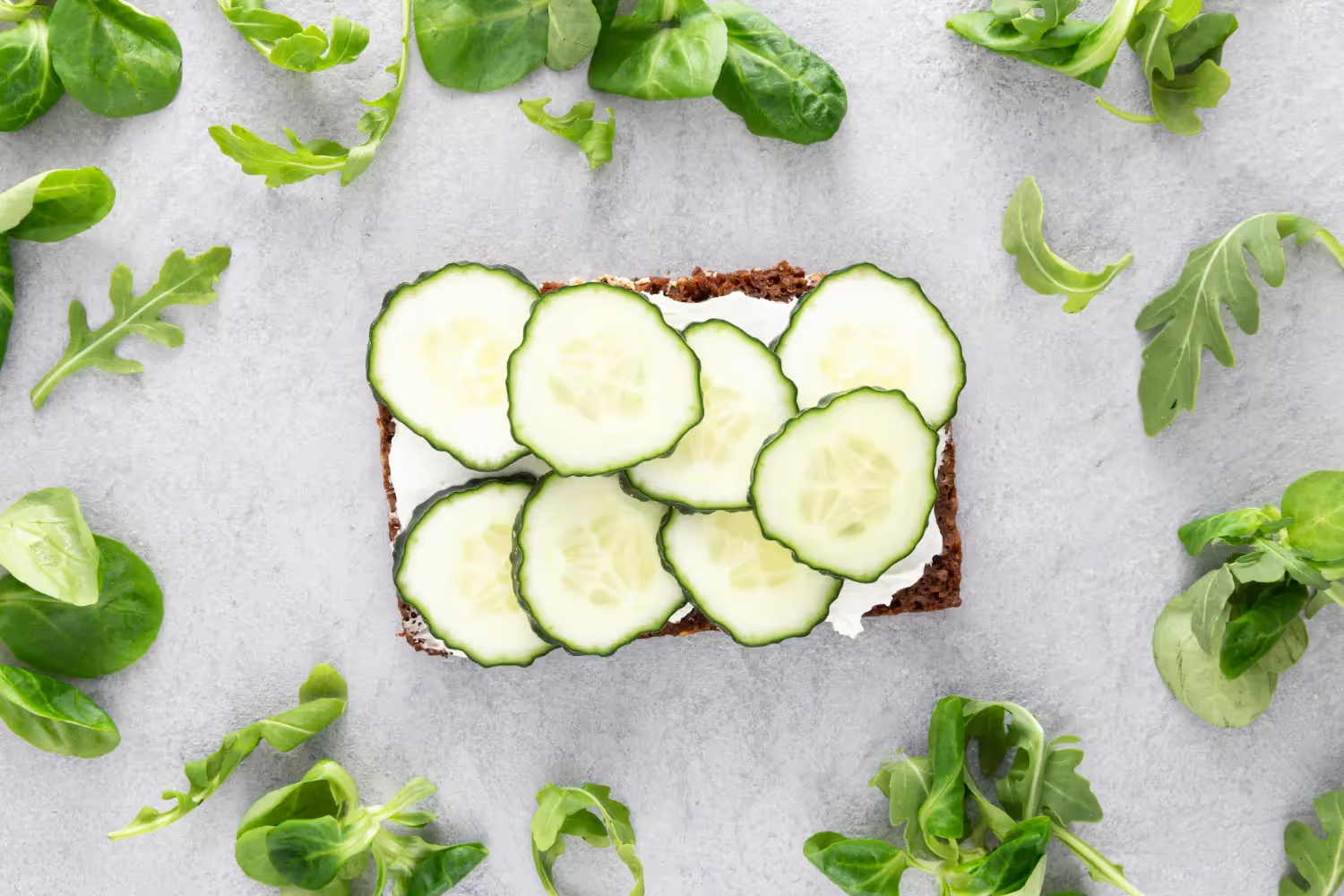
The cucumber diet is a short-term weight loss plan that uses cucumber as the main food in each meal. Like cucumbers, the diet is low-calorie and is centered around a significant calorie restriction of 800 calories/day (kcal), forming a calorie deficit for fat loss. To remedy this, cucumbers can be consumed at any time to improve satiety.
This is unsustainable long-term, and we discourage calorie restriction of this severity as it lacks the calories and nutrients to maintain optimal health.
To address this, we recommend supplementing the diet with lean protein, carbohydrates, and healthy fats. This will also bring calories up to a sustainable level.
Here is a list of suitable foods to support the cucumber diet:
- Animal-based: Chicken, turkey, beef, fish: Salmon, tuna, or seafood, eggs
- Dairy: Greek yogurt, cottage cheese, or milk
- Plant-based: Tofu, tempeh, lentils, or beans, fruits, and vegetables
- Grains: Brown rice, oats, whole wheat bread, quinoa)
Nutritional Profile of Cucumbers
Sources show that cucumbers are low-calorie and consist of 95% water, 0.6% protein, 0.1% fats, and 2.2% carbohydrates. However, within this are vitamins, minerals, and antioxidants, which we list below alongside their benefits:
Your 7-Day Cucumber Diet Plan
The following 7-day diet is a modified version of the cucumber diet that will provide your body with adequate calories and meet your nutritional needs. Each day contains three meals and a snack.
Each meal will contain calorie content, ingredients, and benefits to show you how each meal will not only help you lose weight but also support your health.
Below we list the recommended calorie and macro intake, including the formula to determine the basal metabolic rate (BMR) to identify the calorie allowance, which we can modify to form a realistic and healthy calorie deficit.
BMR Formula
- BMR = 10 x weight (kg) + 6.25 x height (cm) - 5 x age (years) - 161
Using this formula, we will calculate the BMR for a 44-year-old woman who is 170 cm tall and weighs 85 kg.
- 10 x 85 + 6.25 x 170 - 5 x 44 - 161
- 850 + 1062.5 - 220 - 161 = 1531.5 kcal/day
Now, we create a healthy calorie deficit of 300 kcal (331.5 for easy tracking). This will make the diet more sustainable and provide room for additional decreases as weight gradually decreases.
- 1531.5 - 331.5 kcal = 1200 kcal/day
Below is the macronutrient ratio for weight loss.
- Carbohydrates: 40% of daily calorie intake
- Protein: 30% of daily calorie intake
- Fat: 30% of daily calorie intake
Using this information, we divide calories across three meals and a snack.
Day 1 — Hydration Start with Cucumber Smoothies
Breakfast: Cucumber Green Smoothie (350 kcal)
Ingredients
- 1 cup cucumber, chopped (16 kcal)
- ½ frozen banana (53 kcal)
- 1 cup baby spinach (7 kcal)
- ½ cup plain low-fat Greek yogurt (80 kcal)
- 1 scoop vanilla protein powder (100 kcal)
- 1 tbsp chia seeds (58 kcal)
- ¾ cup unsweetened almond milk (30 kcal)
- ½ tbsp peanut butter (46 kcal)
Why it’s great: This smoothie kickstarts your day with hydration, antioxidants, and protein, supporting energy, fullness, and gut health.
Lunch: Chicken Quinoa Cucumber Bowl (350 kcal)
Ingredients
- ¾ cup cooked quinoa (170 kcal)
- 3 oz grilled chicken breast (125 kcal)
- ½ cup chopped cucumber (8 kcal)
- ¼ cup cherry tomatoes (8 kcal)
- 1 tbsp lemon juice (4 kcal)
- 1 tbsp olive oil (40 kcal)
- Fresh parsley (approx. 5 kcal)
Why it’s great: This bowl balances lean protein and complex carbs with hydrating veggies and healthy fats to keep you satisfied and focused.
Dinner: Turkey Lettuce Wraps with Cucumber Tzatziki (350 kcal)
Ingredients
- 3 oz lean ground turkey (93% lean) (160 kcal)
- 1 whole grain wrap (120 kcal)
- 2 tbsp homemade tzatziki (Greek yogurt, grated cucumber, garlic, lemon juice) (40 kcal)
- ¼ cup chopped cucumber (8 kcal)
- ¼ cup shredded romaine or iceberg (5 kcal)
- 1 tsp olive oil (for cooking or drizzling) (17 kcal)
Benefits: These wraps are rich in flavor and nutrients, combining lean protein with probiotic-rich yogurt and water-dense veggies for a light but satisfying dinner.
Snack: Cucumber & Hummus with Almonds (150 kcal)
Ingredients
- ½ cup cucumber slices (8 kcal)
- 2 tbsp hummus (70 calories)
- 8 almonds (72 kcal)
Benefits: This crunchy, protein-boosted snack curbs hunger between meals while supporting hydration and healthy fats intake.
Day 2 — Lean Proteins with Cucumber Salads
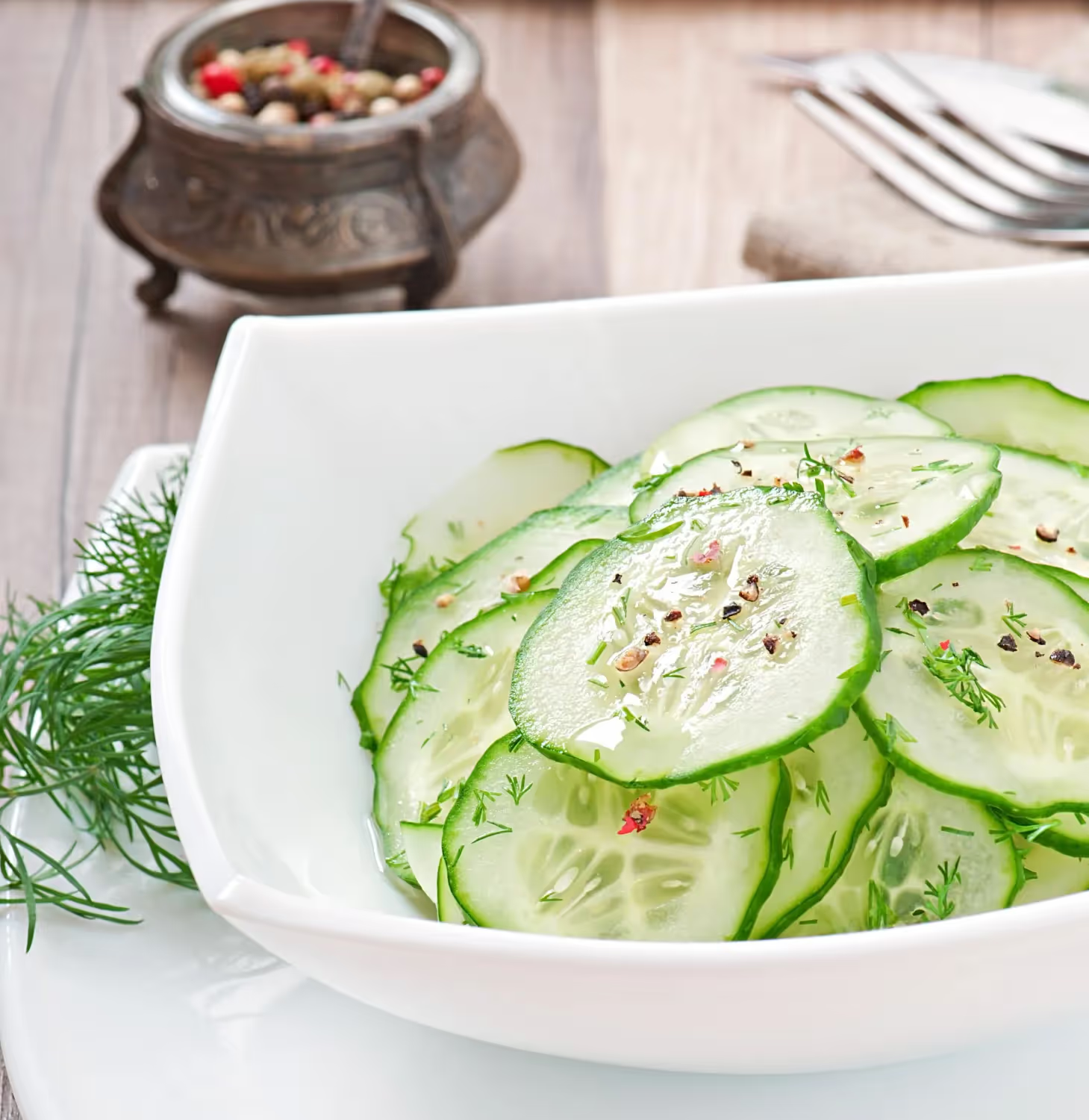
Breakfast: Cucumber, Spinach & Egg Toast (350 kcal)
Ingredients
- 1 slice whole grain bread (100 kcal)
- 2 large eggs (boiled or scrambled) (140 kcal)
- ½ cup diced cucumber (8 kcal)
- ½ cup fresh spinach (5 kcal)
- 1 tsp olive oil (drizzle or sauté) (40 kcal)
- 1 tbsp hummus (spread on toast) (57 kcal)
Why it’s great: This protein-packed breakfast gives you sustained energy and brain-boosting fats, while cucumber and greens help with early morning hydration and digestion.
Lunch: Grilled Chicken with Cucumber Quinoa Salad (350 kcal)
Ingredients
- 3 oz grilled chicken breast – 125 calories
- ½ cup cooked quinoa – 110 calories
- ½ cup cucumber, chopped – 8 calories
- ¼ cup cherry tomatoes – 8 calories
- 1 tbsp olive oil – 40 calories
- 1 tbsp lemon juice – 4 calories
- 1 tbsp chopped fresh parsley – 5 calories
- 1 tbsp crumbled feta (optional) – 50 calories
Why it’s great: A crisp cucumber salad complements hearty chicken and quinoa for a satisfying, refreshing midday meal that’s rich in protein and fiber to help curb afternoon cravings.
Dinner: Turkey Patties with Cucumber Yogurt Salad (350 kcal)
Ingredients
- 3 oz lean ground turkey (93%) (160 kcal)
- ½ cup brown rice (cooked) (110 kcal)
- ½ cup cucumber (grated or chopped) (8 kcal)
- ¼ cup plain Greek yogurt (40 kcal)
- 1 tsp olive oil (40 kcal)
- 1 tbsp lemon juice (4 kcal)
- Fresh dill or mint (optional, garnish) (~5 kcal)
Why it’s great: This dish blends warm comfort with cooling refreshment, balancing lean protein, slow-digesting carbs, and a yogurt-cucumber side for gut-friendly hydration.
Snack: Cucumber Sticks with Hummus & Almonds (150 kcal)
Ingredients
- ½ cup cucumber sticks (8 kcal)
- 2 tbsp hummus (70 kcal)
- 6 raw almonds (72 kcal)
Why it’s great:
This crunchy, protein-rich snack fuels you between meals while supporting hydration and offering healthy fats to keep you full.
Day 3 — Electrolyte-Rich Meals with Citrus and Mint
Breakfast: Citrus Cucumber Mint Smoothie (350 kcal)
Ingredients
- 1 cup chopped cucumber (16 kcal)
- ½ banana (53 kcal)
- 1 scoop unflavored or vanilla protein powder (100 kcal)
- ½ cup low-fat Greek yogurt (80 kcal)
- ½ orange, peeled (40 kcal)
- Juice of ½ lime (5 kcal)
- ¾ cup coconut water (35 kcal)
- 1 tbsp chia seeds (58 kcal)
- Fresh mint leaves (about 5) (3 kcal)
Why it’s great: This cooling smoothie hydrates deeply with cucumber and coconut water, delivers electrolytes from citrus, and packs protein for muscle recovery.
Lunch: Grilled Chicken Cucumber Citrus Salad (350 kcal)
Ingredients:
- 3 oz grilled chicken breast (125 kcal)
- ½ cup cooked farro or quinoa (100 kcal)
- ½ cup cucumber slices (8 kcal)
- ¼ avocado, sliced (60 kcal)
- 1 tbsp olive oil (40 kcal)
- 1 tbsp lemon juice (4 kcal)
- ¼ cup orange segments (20 kcal)
- 1 tbsp chopped fresh mint (3 kcal)
Why it’s great: Packed with potassium and magnesium, this salad replenishes electrolytes while offering clean proteins and complex carbs for all-day energy.
Dinner: Turkey & Brown Rice Lettuce Wraps with Cucumber-Mint Yogurt Sauce (350 kcal)
Ingredients
- 3 oz lean ground turkey (93%) (160 kcal)
- ½ cup cooked brown rice (110 kcal)
- 2 large butter lettuce leaves (5 kcal)
- ¼ cup diced cucumber (8 kcal)
- 2 tbsp plain Greek yogurt (30 kcal)
- Juice of ½ lemon (4 kcal)
- 1 tsp olive oil (40 kcal)
- 1 tbsp chopped mint (3 kcal)
Why it’s great: These wraps deliver hydration and flavor in every bite, combining lean protein with cooling yogurt-mint-cucumber sauce and citrus for electrolyte balance.
Snack: Cucumber Citrus Infused Water + Almonds & Orange Wedges (150 kcal)
Ingredients & Calories:
- ½ cup cucumber slices (8 kcal)
- 6 almonds (70 kcal)
- ½ small orange (30 kcal)
- 1 tsp honey (optional drizzle) (20 kcal)
- Fresh mint and lime in water (~2 kcal)
- Dash of sea salt (0 kcal) (for natural sodium replenishment)
Why it’s great: This hydrating snack fights fatigue with citrus, healthy fats, and a trace of salt to restore electrolytes and keep you alert.
Day 4 — Cucumber and Greek Yogurt Combos
Breakfast: Cucumber Yogurt Toast with Eggs (350 kcal)
Ingredients
- 1 slice whole grain bread (100 kcal)
- 2 large eggs, soft-boiled (140 kcal)
- ¼ cup plain Greek yogurt (40 kcal)
- ¼ cup diced cucumber (8 kcal)
- 1 tsp olive oil (40 kcal)
- 1 tsp lemon juice (2 kcal)
- 1 tsp chopped fresh dill or mint (2 kcal)
- Salt and pepper to taste (0 kcal)
Why it’s great: This breakfast combines hydrating cucumber, protein-rich yogurt, and healthy fats to start your day with clean energy and digestive support.
Lunch: Quinoa Chicken Bowl with Cucumber Yogurt Dressing (350 kcal)
Ingredients
- ¾ cup cooked quinoa (165 kcal)
- 3 oz grilled chicken breast (125 kcal)
- ½ cup chopped cucumber (8 kcal)
- 2 tbsp plain Greek yogurt (30 kcal)
- 1 tbsp olive oil (40 kcal)
- 1 tbsp lemon juice (4 kcal)
- 1 tbsp chopped fresh parsley (3 kcal)
Why it’s great: This bowl is rich in complete proteins, complex carbs, and anti-inflammatory nutrients, while the creamy cucumber-yogurt dressing adds refreshing flavor and probiotics.
Dinner: Turkey Lettuce Wraps with Cucumber Yogurt Sauce (350 kcal)
Ingredients
- 3 oz lean ground turkey (93%) (160 kcal)
- ½ cup cooked brown rice (110 kcal)
- 2 large romaine or butter lettuce leaves (5 kcal)
- ¼ cup grated cucumber (8 kcal)
- 2 tbsp plain Greek yogurt (30 kcal)
- 1 tsp olive oil (40 kcal)
- 1 tsp lemon juice (2 kcal)
- Chopped mint or dill (2 kcal)
Why it’s great: These wraps are protein-packed and low in processed carbs, with a cooling yogurt-cucumber topping that boosts hydration and gut-friendly bacteria.
Snack: Cucumber Yogurt Dip with Veggies and Almonds (150 kcal)
Ingredients:
- ¼ cup Greek yogurt (40 kcal)
- ¼ cup finely chopped cucumber (8 kcal)
- 1 tsp lemon juice (2 kcal)
- 1 cup raw veggie sticks (carrot, bell pepper, cucumber) (25 kcal)
- 6 raw almonds (75 kcal)
Why it’s great: This snack curbs hunger, supports hydration, and combines protein and healthy fats in a refreshing, crunchy package that helps keep your metabolism steady.
Day 5 — Plant Protein with Cucumber-Based Dishes
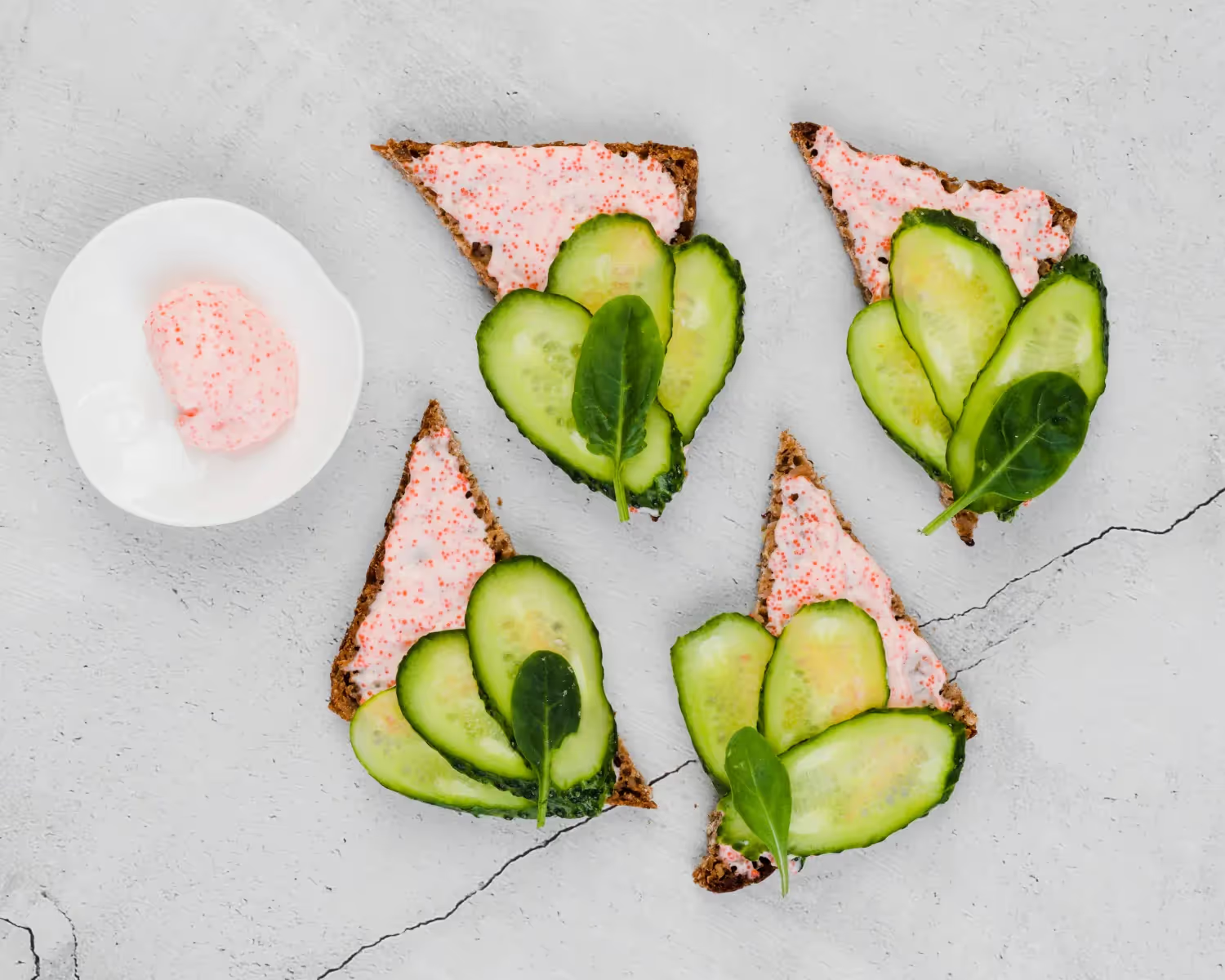
Breakfast: Chickpea & Cucumber Toast with Tahini Yogurt Drizzle (350 kal)
Ingredients
- 1 slice whole grain bread (100 kcal)
- ½ cup mashed chickpeas (135 kcal)
- ¼ cup diced cucumber (8 kcal)
- 1 tbsp tahini (90 kcal)
- 1 tbsp plain plant-based yogurt (coconut or almond) (15 kcal)
- 1 tsp lemon juice (2 kcal)
Why it’s great: This plant-powered breakfast delivers lasting energy with fiber-rich chickpeas and healthy fats from tahini, while cucumber and lemon add hydration and brightness.
Lunch: Quinoa Cucumber Salad with Edamame and Herb Dressing (350 kcal)
Ingredients & Calories:
- ¾ cup cooked quinoa (165 kcal)
- ½ cup shelled edamame (95 kcal)
- ½ cup chopped cucumber (8 kcal)
- 1 tbsp olive oil (40 kcal)
- 1 tbsp lemon juice (4 kcal)
- 1 tbsp chopped fresh parsley or mint (3 kcal)
- 1 tbsp pumpkin seeds (35 kcal)
Why it’s great: This bowl blends complete plant proteins from quinoa and edamame with antioxidant-rich herbs, cucumber for hydration, and seeds for omega-3 support.
Dinner: Lentil & Brown Rice Stuffed Peppers with Cucumber Yogurt Sauce (350 kcal)
Ingredients
- ½ cup cooked green lentils (115 kcal)
- ½ cup cooked brown rice (110 kcal)
- 1 bell pepper (stuffed & baked) (35 kcal)
- 2 tbsp plant-based yogurt (30 kcal)
- ¼ cup grated cucumber (8 kcal)
- 1 tsp olive oil (40 kcal)
- 1 tsp lemon juice (2 kcal)
- Chopped dill or mint for garnish (5 kcal)
Why it’s great: This hearty meal is packed with fiber, plant protein, and cooling cucumber-yogurt sauce for digestion and hydration after a long day.
Snack: Cucumber Sticks with Hummus and Sunflower Seeds (150 kcal)
Ingredients
- ½ cup cucumber sticks (8 kcal)
- 2 tbsp hummus (70 kcal)
- 1 tbsp roasted sunflower seeds (72 kcal)
Why it’s great: This crunchy, protein-rich snack satisfies while replenishing minerals and electrolytes with cucumber, and keeps energy steady between meals.
Day 6 — Anti-Bloat Foods with Cucumber Focus
Breakfast: Cucumber Mint Smoothie with Greek Yogurt & Pineapple (350 kcal)
Ingredients
- ½ frozen banana (53 kcal)
- ½ cup frozen pineapple (40 kcal)
- ¼ cup chopped cucumber (4 kcal)
- ½ cup plain Greek yogurt (80 kcal)
- ¾ cup unsweetened almond milk (30 kcal)
- 1 tbsp chia seeds (58 kcal)
- 1 tsp fresh grated ginger (2 kcal)
- 1 tsp lemon juice (2 kcal)
- 1 tbsp mint leaves (3 kcal)
- 1 scoop collagen or vanilla plant protein powder (78 kcal)
Why it’s great: This smoothie combines anti-inflammatory ingredients like ginger and pineapple with cucumber and chia to reduce bloating, support digestion, and keep you feeling light and full.
Lunch: Quinoa Cucumber Bowl with Fennel, Yogurt Dressing & Herbs (350 kcal)
Ingredients
- ¾ cup cooked quinoa –(165 kcal)
- ½ cup thinly sliced cucumber (8 kcal)
- ¼ cup thinly shaved fennel (10 kcal)
- ¼ avocado (60 kcal)
- 2 tbsp plain Greek yogurt (30 kcal)
- 1 tbsp lemon juice (4 kcal)
- 1 tsp olive oil (40 kcal)
- 2 tbsp chopped parsley and mint (3 kcal)
- Salt and black pepper (0 kcal)
- Optional: 1 tbsp pumpkin seeds (30 kcal) (adjust for protein/fat needs)
Why it’s great: Cucumber, fennel, mint, and lemon all have natural diuretic and digestive benefits, helping reduce water retention and support a flat belly while keeping meals satisfying.
Dinner: Lentil Stuffed Zucchini with Cucumber Yogurt Topping (350 kcal)
Ingredients
- ½ cup cooked lentils (115 kcal)
- ½ cup cooked brown rice (110 kcal)
- 1 medium zucchini, halved and hollowed (30 kcal)
- ¼ cup chopped cucumber (4 kcal)
- 2 tbsp Greek yogurt (30 kcal)
- 1 tsp olive oil (40 kcal)
- 1 tsp lemon juice (2 kcal)
- 1 tbsp chopped mint (3 kcal)
- Dash of cumin and sea salt (0 kcal)
Why it’s great: Zucchini, cucumber, and mint are all natural debloaters, and paired with lentils and yogurt, they help regulate digestion while delivering plant-based protein and fiber.
Snack: Cucumber & Carrot Sticks with Hummus and Lemon Zest (150 kcal)
Ingredients
- ½ cup cucumber sticks (8 kcal)
- ½ cup carrot sticks (25 kcal)
- 2 tbsp hummus (70 kcal)
- 1 tsp lemon zest (2 kcal)
- 1 tbsp chopped parsley or mint (2 kcal)
- 6 almonds (43 kcal)
Why it’s great: This crunchy, hydrating snack supports digestion and reduces bloating with lemon and raw veggies, while protein and healthy fats keep you full and energized.
Day 7 — Light Wrap-Up with Variety and Fiber
Breakfast: Cucumber-Avocado Toast with Hemp Seeds and Berries (350 kcal)
Ingredients
- 1 slice sprouted whole grain bread (100 kcal)
- ½ avocado, mashed (120 kcal)
- ¼ cup finely sliced cucumber (4 kcal)
- 1 tbsp hemp seeds (55 kcal)
- ½ cup mixed berries (35 kcal)
- 1 tsp lemon juice + sea salt (2 kcal)
- ½ tsp chia seeds (10 kcal)
- Optional fresh dill or mint for garnish (4 kcal)
Why it’s great: This breakfast is packed with soluble fiber from berries, chia, and avocado, while cucumber adds hydration and crunch for digestive ease and bloat reduction.
Lunch: Fiber-Full Cucumber Chickpea Salad with Quinoa and Herbs (350 kcal)
Ingredients
- ½ cup cooked quinoa (110 kcal)
- ½ cup canned chickpeas (rinsed and drained) (120 kcal)
- ½ cup chopped cucumber (8 kcal)
- ¼ cup diced bell pepper (12 kcal)
- 1 tbsp olive oil (40 kcal)
- 1 tbsp lemon juice (4 kcal)
- 2 tbsp fresh parsley and mint mix (3 kcal)
- 1 tbsp pumpkin seeds (35 kcal)
- Pinch of cumin or black pepper (0 kcal)
Why it’s great: This hearty, colorful salad brings in a wide array of fiber sources—quinoa, chickpeas, and seeds—while cucumber, lemon, and herbs enhance digestion and flavor.
Dinner: Stuffed Sweet Potato with Cucumber Tzatziki and Lentils (350 kcal)
Ingredients
- 1 small roasted sweet potato (about 150g) (130 kcal)
- ½ cup cooked lentils (115 kcal)
- 2 tbsp plant-based Greek-style yogurt (30 kcal)
- ¼ cup grated cucumber (4 kcal)
- 1 tsp olive oil (40 kcal)
- 1 tsp lemon juice + minced garlic (2 kcal)
- 1 tbsp chopped dill or parsley (3 kcal)
- Sprinkle of black pepper or paprika (0 kcal)
- 1 tbsp sunflower seeds (optional topping) (26 kcal) (adjust to balance macros)
Why it’s great: Fiber-rich lentils and sweet potato provide slow-digesting carbs, while the cucumber tzatziki delivers cooling, anti-inflammatory properties and a creamy contrast.
Snack: Cucumber Ribbons with Hummus and Flax Crackers (150 kcal)
Ingredients
- ½ cup cucumber ribbons (8 kcal)
- 2 tbsp hummus (70 kcal)
- 2 flaxseed crackers (65 kcal)
- Sprinkle of smoked paprika or lemon zest (2 kcal)
Why it’s great: A satisfying combo of protein, fiber, and healthy fats, this snack supports digestive health while offering crunch and hydration from cucumber and flax.
Should You Follow the Cucumber Diet Long-Term?
The cucumber diet should not be followed long-term as it lacks the calorie content and nutrient density to sustain overall health.
However, if the cucumber diet is complemented with lean protein, complex carbohydrates, and healthy fats, it may be used for long-term health
When to Use as a Reset — and When Not To
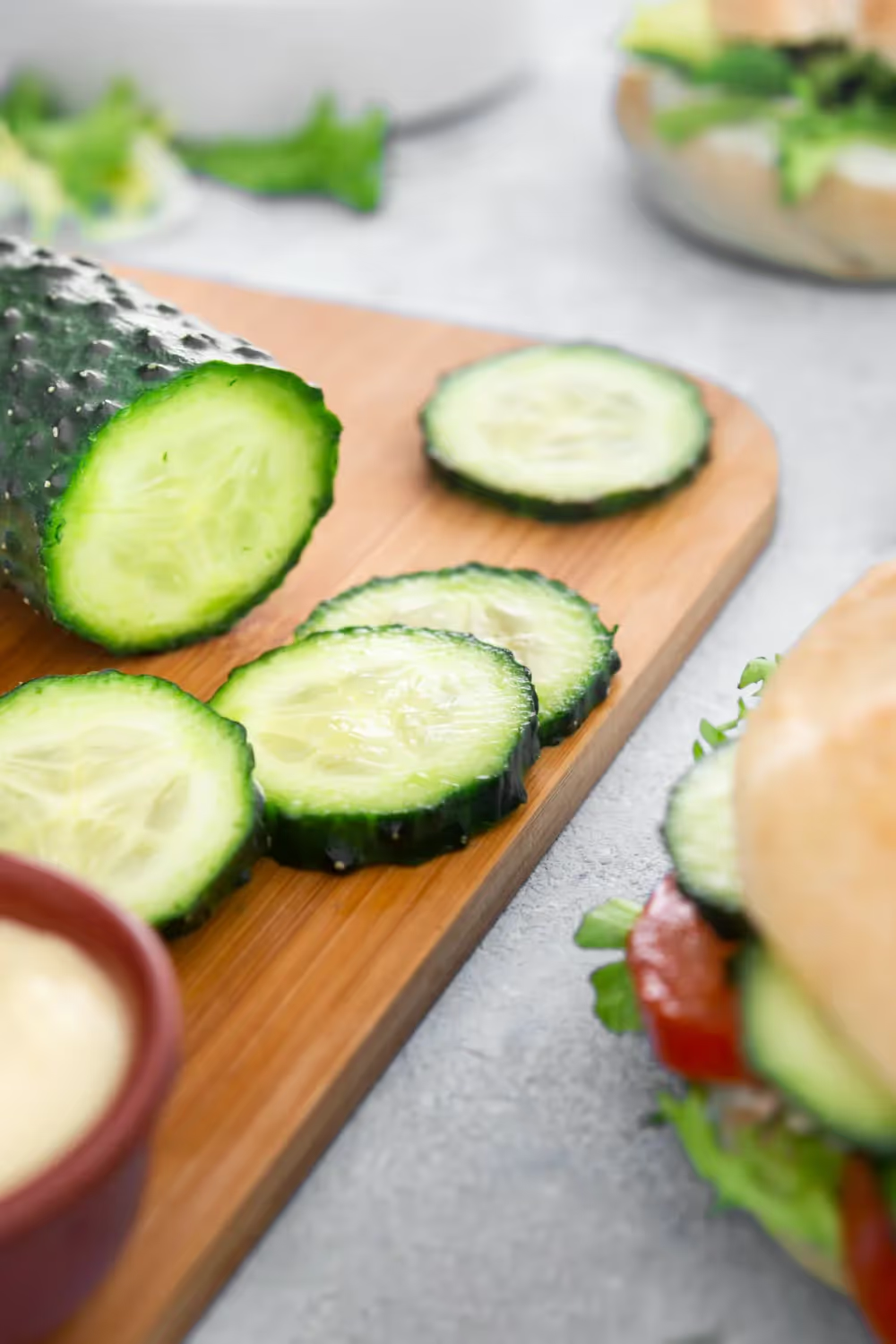
Our modified version of the cucumber diet focuses on low-calorie, nutrient-dense foods, which makes it great for kickstarting fat loss.
Poor nutrition can lead to feelings of fatigue, sluggishness, and poor digestion. The cucumber diet contains lighter, low-calorie meals that are high fiber and hydrating, which can reduce body weight, improve digestion, and boost energy levels.
However, it is not always suitable to use as a reset, especially if you have been stacking detox diets or have been on a severe calorie restriction, as it may not contain adequate nutrients for optimal health.
Adjusting for Hormonal and Metabolic Needs
The standard cucumber diet focuses on stripping back nutrition for aggressive weight loss, which leaves little nutritional value for hormonal and metabolic support.
Fortunately, the modified version above addresses this with lean protein, healthy fats, and complex carbohydrates.
Protein is highlighted as one of the most important compounds in the body, providing the building blocks for cell structure, tissues, enzymes, and hormone production. Healthy fats support metabolism by assisting with nutrient absorption and are shown to contribute to hormone regulation.
Meanwhile, sources show that complex carbohydrates release a gradual increase in blood sugar while supporting digestive health.
Safer Alternatives with Similar Benefits
Nutrition plans with the word ‘diet’ often give off the fad diet vibes, which promise a quick fix, but are nothing more than a severe calorie restriction.
The safest alternative to the cucumber diet is to enter a reasonable calorie deficit (200–300 kcal/day) while consuming nutrient-dense whole foods and a focus on hitting your macronutrient targets.
A calorie deficit can lead to hunger. However, by eating lean protein, complex carbohydrates, and healthy fats, you can create meals that provide sustainable energy, vital nutrients, improve gut health, and preserve muscle mass. Providing greater current and long-term benefits, enhancing health and well-being.
Recap — What This 7 Day Cucumber Diet Can Do
The 7-day cucumber diet can help you lose weight; however, it involves severe calorie restriction which means it is unsustainable.
If you are considering trying the cucumber diet, we strongly recommend you select our modified version based on a healthy calorie deficit. Here you can modify the calorie intake to your needs, to ensure you are adequately fueling your body and providing it with vital nutrients for optimal health.
Bloating Relief and Hydration Boost
To avoid bloating and boost hydration during your nutrition plan, focus on adequate water intake.
Sources show adequate hydration is responsible for regulating core body temperature, digestion, cognitive function, and even hormonal health.
Research shows that the recommended daily intake for women is 2200 ml/day. To achieve these goals, we suggest taking regular sips throughout the day and a glass of water before each meal to improve digestion and reduce bloating.
Short-Term Reset with Long-Term Mindfulness
Short-term nutrition plans tend to be far too aggressive for long-term sustainability. However, they can strip back nutrition to the essentials and instill healthy eating habits.
Sadly, while the cucumber diet does strip back the processed foods, it does so in a way that teaches poor nutrition habits.
Our modified cucumber diet, on the other hand, provides nutrient-dense foods while instilling healthy eating practices, which can improve long-term health.
Tools for Sustainable Weight Wellness
Sustainable weight loss isn’t just always about what we eat. It also comes with how we monitor our eating habits and track our nutrition.
One way to achieve this is with Reverse Health, a dedicated nutrition and fitness platform for women over 40. Offering nutrition tracking, exercise, and recipes which are all designed to optimize health and provide hormonal regulation.
Sources
- Uthpala, T.G.G., Marapana, U., Lakmini, P.C. and Wettimuny, D., 2020. Nutritional bioactive compounds and health benefits of fresh and processed cucumber (Cucumis sativus L.). https://doi.org/10.13140/RG.2.2.17510.04161. https://www.researchgate.net/publication/344270982_Nutritional_Bioactive_Compounds_and_Health_Benefits_of_Fresh_and_Processed_Cucumber_Cucumis_Sativus_L
- LaPelusa, A. and Kaushik, R., 2022. Physiology, Proteins. In: StatPearls [Internet]. Treasure Island (FL): StatPearls Publishing; 2025 Jan–. Available at: https://www.ncbi.nlm.nih.gov/books/NBK557567/
- Mumford SL, Chavarro JE, Zhang C, Perkins NJ, Sjaarda LA, Pollack AZ, Schliep KC, Michels KA, Zarek SM, Plowden TC, Radin RG, Messer LC, Frankel RA, Wactawski-Wende J. Dietary fat intake and reproductive hormone concentrations and ovulation in regularly menstruating women. Am J Clin Nutr. 2016 Mar;103(3):868-77. doi: 10.3945/ajcn.115.119321. Epub 2016 Feb 3. PMID: 26843151; PMCID: PMC4763493. https://pubmed.ncbi.nlm.nih.gov/26843151/
- Holesh JE, Aslam S, Martin A. Physiology, Carbohydrates. 2023 May 12. In: StatPearls [Internet]. Treasure Island (FL): StatPearls Publishing; 2025 Jan–. PMID: 29083823. https://pubmed.ncbi.nlm.nih.gov/29083823/
- Meinders AJ, Meinders AE. Hoeveel water moeten we eigenlijk drinken? [How much water do we really need to drink?]. Ned Tijdschr Geneeskd. 2010;154:1757. Dutch. PMID: 20356431. https://pubmed.ncbi.nlm.nih.gov/20356431/
FAQs
How much weight can I actually lose on a 7-day cucumber diet?
This is a very low-calorie plan, so most of the initial weight loss will be water weight. While some people report losing several pounds, it's best to view this diet as a short-term "reset" to de-bloat and kickstart healthier habits, not as a sustainable, long-term fat loss solution.
Will I be eating only cucumbers for 7 days?
No, a healthy cucumber diet plan should not consist of cucumbers alone. Our plan incorporates cucumbers as the main low-calorie base but also includes sources of lean protein (like eggs or chicken), other non-starchy vegetables, and small amounts of healthy fats to provide essential nutrients and help you feel more satisfied.
Is it safe to follow a cucumber diet?
For most healthy individuals, a 7-day plan is generally safe. However, because it's highly restrictive and low in calories, it's not recommended for long-term use. It's crucial to listen to your body and discontinue the plan if you feel weak or unwell. We always advise consulting a doctor before starting any new, restrictive diet.
Will I feel hungry all the time on this diet?
While this is a low-calorie diet, cucumbers have a high water content, which can help you feel full and stay hydrated. The inclusion of lean protein in our plan is specifically designed to increase satiety and curb hunger pains, making the 7 days more manageable.
What should I do after the 7-day diet ends to avoid regaining the weight?
This is a critical step. The cucumber diet is a temporary tool, not a permanent lifestyle. Our guide includes a post-diet transition plan that shows you how to gradually reintroduce other healthy food groups and maintain a balanced, sustainable diet to preserve your results and continue your health journey.








